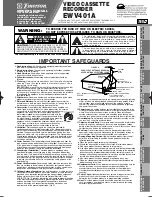
Chapter 1
Overview
25
(GB)
Chapter 1 Overview
1
Video signal input/output section
1
VIDEO OUT1 connector (BNC-type)
Outputs composite video signals. Connect to the input
connector of an external monitor. If the
SUPERIMPOSE switch
3
has been set to ON, text
data (time data, menus and alarm messages) is
superimposed.
For details on the superimposed data, see “Text data
superimposed on the LCD monitor” on page 17 (GB).
Notes
• When a video sync signal of the EE pictures are
output to the VIDEO OUT1 connector, sync and
burst are not synchronized.
Note
You only can input standard video signals to the unit.
If you input the types of video signals shown below,
the EE picture output to the VIDEO OUT2 connector,
S VIDEO OUT connector and COMPONENT
OUTPUT connectors may be distorted.
• Signals from some home game machines
• Blue background screen or gray background screen
from a consumer VCR
• Pictures played at a speed other than normal by a
VCR that does not have the TBC (Time Base
Corrector)
• Video signals in which the sync signals are distorted
• Signals from a defective cassette (tape or recording
condition is bad) played by an analog VCR that does
not have the TBC
• The video signal output from this connector is not
synchronized with the video signal output from the
line-out connectors (COMPONENT OUTPUT, S
VIDEO OUT, VIDEO OUT2). When the unit is in
the EE mode, the output pictures are delayed by
several lines. When played, the picture is not
externally synchronized — only vertically
synchronized. You cannot adjust the sync and
subcarrier phases.
• If DV input has been selected, color and luminance
may be distorted in the EE mode, depending on the
monitor type.
3
SUPERIMPOSE switch
4
S VIDEO IN/OUT connectors
5
VIDEO/REF. IN connector
6
VIDEO OUT2 connector
7
COMPONENT OUTPUT
connectors
1
VIDEO OUT1 connector
2
INPUT SELECT selector
















































